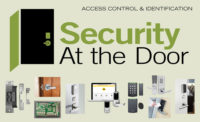Wireless locks today are much more than the standalone, battery-operated locks of the past. While they still are experiencing a few growing pains, more often they are being considered a viable alternative to — and even replacement for — hardwired locks.
“Customers looking for lower-cost alternatives to hardwired systems are what started the whole wireless trend,” describes Mark Shellberg, product line manager for electronic access control products, Kaba Access and Data Systems, Winston-Salem, N.C. “These same customers are expecting hardwired features such as instant programming, door monitoring and other things a standalone lock can’t do.”
Wireless technology is all around us, from cell phones to Wi Fi at the local coffee shop or grocery store.
“It really is wireless everywhere,” says Garrett Lovejoy, electronic access control product manager, Architectural Hardware Group (AHG), ASSA ABLOY, New Haven, Conn. “People have accepted that it is a good solution and now want to use it for everything they can.”
Wireless locks also have moved beyond doors in recent years. Cabinets, non-traditional openings, gates, elevators and other areas that were traditionally not part of the electronic sphere have become secured places, largely because of wireless locks.
“I think anything we can attach wireless to and control and understand ‘who, what, where and when,’ we are looking to do that,” says John LaFond, vice president of integrated systems, Linear LLC, Carlsbad, Calif. “Today we might see commercial locksets on doors but that is evolving down to cabinets and anything else we can control electronically. We see that trend becoming bigger and bigger.”
It is an exciting time in the wireless locking market, says Adam Auer, product manager for Securitron, EMS & OEM Group, ASSA ABLOY, Phoenix, Ariz. “I expect to continue to see them be more widely accepted and more common in the workplace, with a proliferation of form factors. Wireless has opened the eyes of consumers and users to the idea that they can secure a lot of other devices as well.”
There are three distinct types of technology users, says Stephen “Shep” Sheppard, director of sales, North America, Farpointe Data Inc., Sunnyvale, Calif. “Some will embrace it immediately. Others will sit on the fence, see how it goes and try it out a little bit. The last are set against it. What we are seeing with wireless locksets, now that they have been out for a while, is some of the fence-sitters are moving towards it and even some of the nay sayers.”
This applies to integrators as well as end users, he adds. “You can’t argue with the ease of installation of wireless and the ability to reach that door you just can’t get a wire to. Using wireless beats trying to wrestle with a tough install.”
One of the reasons for this acceptance may be the proliferation of different types of wireless that fit a variety of needs, says Karen Keating, portfolio marketing manager for electronics, Allegion PLC, Carmel, Ind. “We continue to see growth. There are a variety of types of wireless and it seems like the adoption of these various types of technologies is accelerating. OEM access control providers are really beginning to embrace it and integrators are, as well.”
One such integrator is Trey West, vice president, Knight Security Systems, Dallas. “We are pretty excited about this stuff,” he says. “We recently had a wireless installation of 1,300 doors. That got our attention pretty fast and really opened our eyes to the potential of these wireless locksets.”
Wireless Types
From the integrator’s perspective, the fact that there are significant technological differences among wireless access control products is advantageous. “There are differences in technologies and not every wireless system delivers the same functionality or capabilities,” Keating says.
One of the most recognized is Wi-Fi, which has the ability to work within the existing IT infrastructure and is appealing to many people.
“Standard IP wireless (Wi-Fi) is already in the building,” Lovejoy says. “Our wireless locks directly connect to the building, which generally means zero infrastructure cost. With Wi-Fi you can put a lock on the door, connect it to the wireless that is already in the building and tie it back to the access control system without disturbing anything in the entire site, all at the absolute lowest cost of any of the wireless solutions. The majority of applications for Wi-Fi-based wireless locks are in need of an audit trail and want to use the card they already have. That is where Wi-Fi shines.”
While wireless has its advantages in terms of leveraging infrastructure so the integrator does not have to create a separate network, the downside is that if the end user needs any immediacy, such as the ability to lockdown a facility or have real-time reporting, Wi-Fi uses more power and can drain the battery very quickly. Wi-Fi-based systems typically constrain themselves to checking in with the head-end once or twice per day.
Allegion offers a solution based on 900 MHz technology, Keating describes. “We have been able to develop the technology to enable lockdown in real time in 10 seconds or less. The No. 1 requested change that kept coming up when we were doing our voice-of-the-customer research was the ability to have real-time lockdown.”
900 MHz is more like hardwired in terms of functionality, West says. “Because it can wake up and check in every 10 seconds without sacrificing battery life it becomes almost a real-time solution just like a wired door.”
ZigBee wireless is another increasingly popular option with manufacturers and integrators. ZigBee operates at the 2.4 GHz range, Shellberg explains. “The beauty of ZigBee is it was designed to transport small amounts of data, so its biggest benefit is it uses very little power, which means longer battery life. For those smaller applications, we can have up to 100 locks running out of a PC’s USB port without the need for another network.”
Based on a mesh network design, ZigBee allows for redundancy, he adds. “You can overlap the gateways/routers and if one goes down the other one takes over. It is a self-healing network. Our system pings every 6 seconds to enable real-time lock monitoring and sub-10 seconds system lockdowns.”
In the home automation industry, Z-Wave is a protocol that also uses 2.4 GHz. An alliance of companies have formed for both Z-Wave and ZigBee to standardize these protocols among the participating manufacturers.
“We use ZigBee and Z-Wave on connected products that work with panels,” says Keith Brandon, director of sales and marketing for residential access solutions, Kwikset, Lake Forest, Calif. “For the most part they both work well within a mesh technology environment. As you add more devices, they work inherently better together, giving you better coverage”
LaFond agrees. “One of the advantages of Z-Wave is that as you add components, the signals get stronger. The more systems you have, the better its performance.”
Like ZigBee and Z-Wave, ASSA ABLOY’s proprietary Aperio protocol also communicates in the 2.4 GHz range. “It enables more frequent contact with the access control system,” Auer explains. “It gives true real-time access control in that every time a card is read the central database is queried. It is real time and very low power compared to Wi-Fi, but it is not ubiquitously installed yet like Wi-Fi.
“I think clearly Wi-Fi protocol is widely accepted now. Aperio is becoming more widely accepted, as is 900 MHz, ZigBee and Z-Wave. I think we are down to about five viable protocols from a much larger number in the past.”
This means clearer and more well-defined choices for the integrator, says Jeff Strangio, sales and estimating, Maffeys Security Group, Elizabeth, N.J. “I have used all of them and in my experience, in the older buildings it can be better to run 900 MHz because it tends to go around corners better. ZigBee is better with line-of-site over longer distances.”
The important thing to remember is that they all work. However, they all have their places. “It’s not about picking one technology over another,” Lovejoy advises. “It’s about picking the right thing for what you are doing.”
Wireless Today & Tomorrow
For the integrator, wireless presents a great opportunity for more doors or non-traditional openings, and easier and quicker installations. “It’s really about the time to install and the productivity they can gain,” Keating says. “From a business standpoint, if they are able to go out and address more applications because of this simplified approach, they can become more efficient.”
Wireless absolutely saves installation time and dollars, especially in retrofit installations, West adds. “We are going back into older buildings with problematic construction like school buildings with concrete or cinderblock walls. Wireless locksets really alleviate problems. If you can install in under an hour and integrate with the access control system — that is pretty special.”
Strangio agrees. “I think manufacturers have gotten the wireless part down and their application is good, especially where you have a lot of older buildings. I think in the next three to five years they are going to explode. They will be one of the more popular locks. My first couple of projects I dragged my feet because I was nervous about connectivity. Now I know what to look for when I survey. I go in there with confidence of knowing that they work. All of the wireless systems have worked but they each have their applications.”
One of the keys to selling and installing wireless is catering to the project — not the technology, Lovejoy says. “It is about making sure you have wireless technology that matches the type of infrastructure the user is looking for.”
Integrator needs to do their homework up front, Keating adds. “They have to understand the IT infrastructure. Are there additional costs that might be incurred for an additional node? There are advantages and disadvantages to every wireless approach out there. What do they need and what problems are they looking to solve? What is the initial budget? What is the ongoing cost budget? Make sure the solution is appropriate for the client.”
One thing to make sure of, West cautions, is that the wireless product and access control system will work together. “There is a synergy that can’t be ignored. They need to work well together. You can’t just grab any wireless product and hope for the best.”
The bottom line, LaFond says, is every dealer and integrator should have one or more wireless solutions in their toolbox. “If I were an integrator I would absolutely have a wireless portfolio that I have researched, qualified and have available for my staff to sell and deploy. Where hardwired becomes cost-prohibitive it becomes an easy trade-off.”
Wireless today is very good and getting better, Shellberg says. “Wireless still has a little latency as far as real-time information, but for most installations today it is 100 percent acceptable. I think going forward there will be improved power utilization to increase battery life and more immediate response.”
As more and more things drive to wireless, technology will continue to get better on power and come closer to being an online thing, Lovejoy adds. “We are probably only a few years away from the tipping point, so now is the time for integrators to learn how to do it.”
West couldn’t agree more. “Wireless today can pretty much do as much as wired. If you had asked me a year ago, I would have said wireless was still a niche product. But with all the hurdles starting to come down — with battery life currently at two years, ease of installation, real-time check-in — that all starts knocking down the barriers that separated wireless from wired.
West adds, “Anything you can do to reduce running wire in a building is desirable. I think it entirely possible that wireless could take over and become the predominant tech of the future.”
What’s in a Site Survey?
Unless you are using Wi-Fi, which uses the wireless network already in place in the building, you will be creating your own network using one of the other choices such as ZigBee, Aperio or 900 MHz.
“Every choice between protocols ends up being an engineering decision,” says Garrett Lovejoy of AHG, ASSA ABLOY. “Either you use the Wi-Fi in the building or you build your own network, which is more work on the integrator side. If you have to deploy a network you need to walk the building and survey it.”
Wireless devices have an optimal range and direction to be pointed in, says Adam Auer of Securitron, EMS &OEM Group, ASSA ABLOY. “Depending on what the building is like there may be obstructions that interfere with some of the signals. We conservatively set our ranges within 50 feet so customers won’t be disappointed.”
There is work that needs to be done up front, says Karen Keating of Allegion PLC. “The site survey allows you to know what openings you are looking to connect via wireless and what the opportunities are for panel interface devices.”
The site survey is critical, says integrator Trey West of Knight Security Systems. “First of all you have to determine the door type. Are they double doors or single? Solid metal or wood? There are places where it works well and others where it doesn’t. You have to plan for the installation of wireless transceivers. These are some of the installation challenges.”
Many manufacturers offer special tools to help with this, and some integrators even have come up with their own.
“There can be Wi-Fi interference, but we have different ZigBee channels to select to avoid that,” says Mark Shellberg of Kaba Access and Data Systems. “When they do a site survey our survey units can detect existing Wi-Fi networks in the area and what channel they are on so they can select alternative channels.”
Integrator Jeff Strangio of Maffeys Security Group, finds a little ingenuity can go a long way. “We had one situation where we realized that the ZigBee modules were mimicking the Wi-Fi wireless antennas, so for estimating purposes we just counted the wireless points in the building. Then we sat down with the IT guy and identified two dead spots where we needed to put in extra modules. On another project, one of our IT guys came up with a great idea. Instead of getting an extension cord and going up to each door, I had used a 12V battery pack and a painter’s pole to put an Allegion PIM device on the head of it, but we couldn’t do that with ZigBee. Then we realized that it uses a USB, so we did the same thing with an external cell phone charger.
“Site surveys are not something you can do from a desk. With wireless you have to be onsite. A lot of times there may be 15 doors in a hallway, but they are all recessed and sometimes even the paint on the wall will bounce back the signal.”









